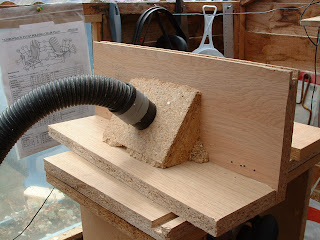I've not read through the whole book yet, but I've come accross so many useful and insiteful snippets thus far I felt I had to blog about it instead of tweeting at Christopher Schwarz @RudeMechanic, Marc Spagnuolo @WoodWhisperer and the rest of the crew I've been bugging with my tweets. Sorry guys, I just get over excited some times. Below is a little snippet our hero has to say about design.
"No ammount of added ornament or excellence of finish can make a badley designed structure look well. Everyone can remember examples where much skill and labour has been expended on work desigend on wrong lines. The result is always that the eye turns away from it dissatisfied. But good design will give pleasure to the beholder even when the finish is not perfect."
Worth some thought there the next time you work from a rough sketch without paying attention to the design details. I've been guilty of that on more than one occasion, and ended up disappointed with the results.
And next time you think you're too tired to do any more work, thing on this little extract:
"Many of our men walked four to five miles daily to work at distant places. Grandfather frequently retold his early feats of strengh and endurence, of walking to and from Swanbourne, for instance ( about 17 miles) , where he did a days work of carpentry, carrying his tools each way. He admitted he was tired on his return."
And they carried their tools! Imagine humping a table saw 4 miles or 17! to a job? I think hand tools would be the order of the day, (they had no such thing as electric tools then anyway) and not that many of them.
Here's an extract on how the usable wood in a fallen tree was calculated. I can't quite wrap my head around it, see what you think:
"For the measurement of trees my father always used a string and a slide rule. As the trunks of trees taper lenghtwise, the middle was taken as the average girth round which the string was passed. I have helped him many times, holding the string carefully with my fingers at the place where it terminated the circumference as measured, afterwards doubling it and then redoubling it twice, with the result that the folds held in my hand were each an eighth of the total circumference. Then he would direct me to drop one eighth part- this an allowence for the bark- and double the remaining seven eighths twice. Each fold of the string was now one-fourth part of the seven eighth of the circumference. He would take the lenght of this with his rule. The measurement thus arrived at represented the "girth", or one side of a squared log, supposing the content of the log to have been square instead of round. On that basis he would then ascertain the cubic content of the log by the use of his slide rule"
What now? Can anyone explain this?
I'm just starting the chapter entitled "Tools" and will update this blog accordingly. Why not drop back in a few days.





































